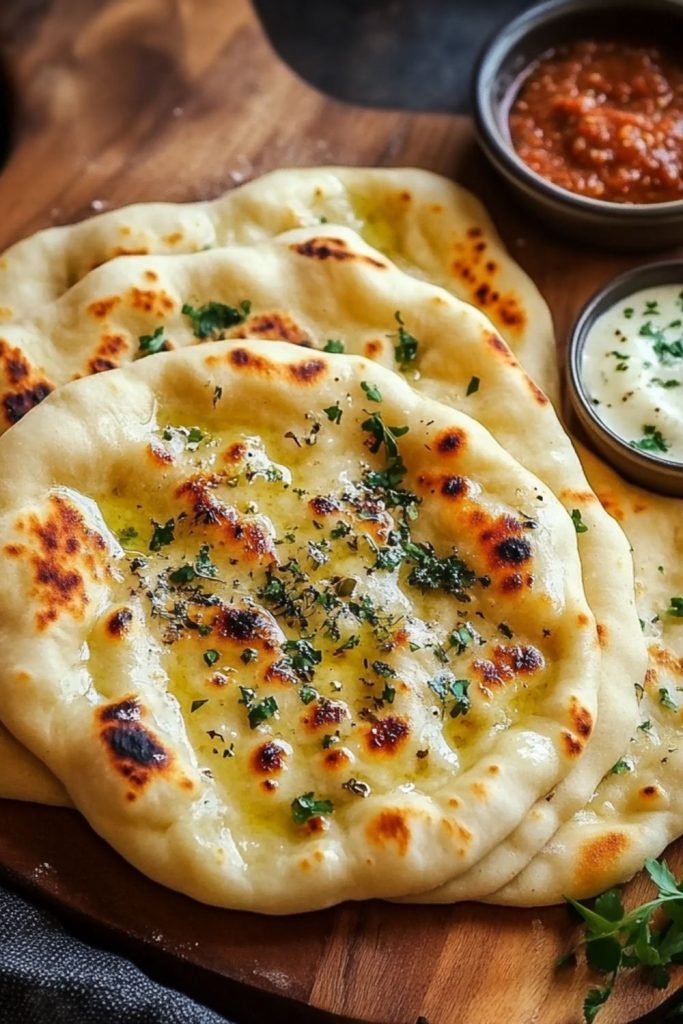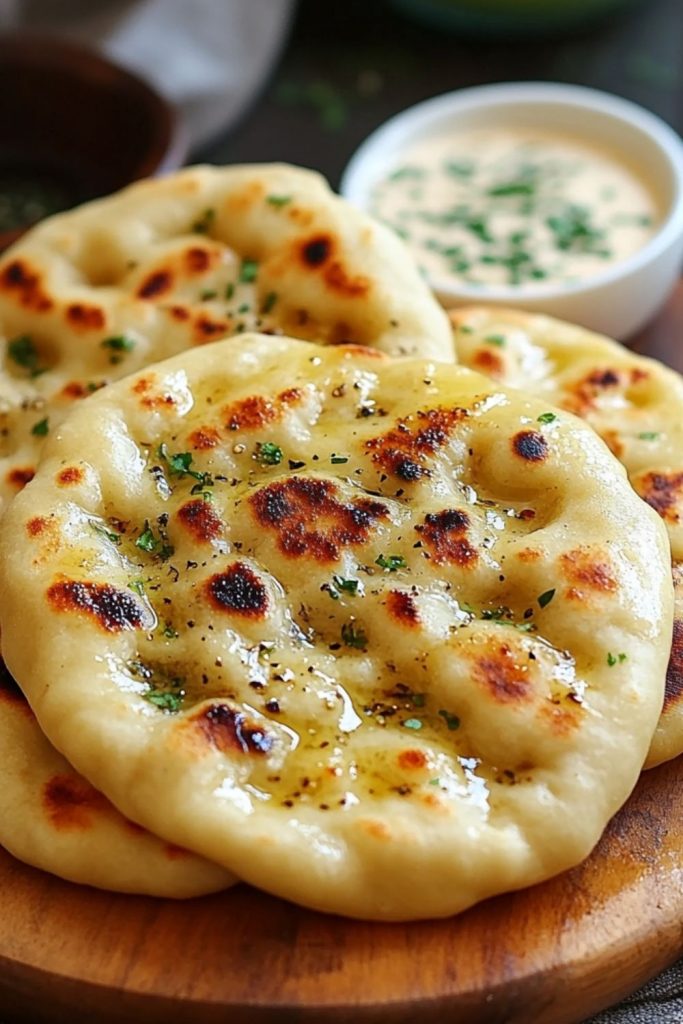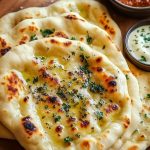I’ve always had a soft spot for pillowy, golden naan bread—the kind that’s slightly charred on the outside, buttery and fluffy inside, and just irresistible when it’s fresh off the skillet. When I discovered how easy it is to make naan at home, it honestly changed my entire bread game. No more relying on store-bought versions that lack that warm, chewy magic. Once you make it from scratch, you’ll see why it’s completely worth the effort.

This Homemade Naan Bread recipe is one I come back to over and over again. It’s perfect for scooping up curries, dipping in sauces, or enjoying just with a bit of garlic butter on top. The dough is simple, flexible, and forgiving—even if you’ve never baked bread before. I’ll walk you through everything you need to get that authentic restaurant-style naan on your table.
Why You’ll Love This Homemade Naan Bread
- Soft, chewy, and beautifully blistered just like at your favorite Indian restaurant.
- Requires no fancy equipment—just a hot skillet and simple ingredients.
- The dough is easy to handle and rises quickly.
- Perfect for pairing with countless dishes or enjoyed on its own.
- You can flavor it however you like—garlic, cheese, herbs, or keep it plain.
- Freezes beautifully for later use.
What Kind of Flour Should I Use for Homemade Naan Bread?
I typically use all-purpose flour for my naan bread—it gives the perfect balance of softness and structure. It’s also readily available and makes the dough easy to knead. If you’re looking to add a slightly nuttier flavor or more chew, you can substitute a portion of it with whole wheat flour, but be aware it will slightly change the texture. For a lighter, more delicate naan, some people even use bread flour because of the higher protein content, but all-purpose remains my go-to for that classic feel.
Options for Substitutions
One of the reasons I love making naan bread at home is how flexible the recipe is. If you don’t have all the exact ingredients, there are several swaps you can make:
- Yogurt: Yogurt gives naan its signature softness and slight tang. If you don’t have it, you can use sour cream or buttermilk. For a dairy-free version, try plain coconut yogurt.
- Milk: Regular milk adds richness, but any non-dairy milk like almond or oat works well too.
- Sugar: Just a small touch of sugar helps activate the yeast and balance flavors. Honey or maple syrup are great natural alternatives.
- Yeast: I use active dry yeast, but instant yeast also works—just skip the proofing step and mix it straight into the flour.
- Butter: You can brush your naan with melted butter, ghee, or olive oil. For a vegan twist, use a plant-based butter.
These swaps make it easier to adapt the recipe based on your pantry or dietary needs without compromising taste or texture.
Ingredients for This Homemade Naan Bread
- All-Purpose Flour
This forms the base of the dough. It provides structure while keeping the naan soft and chewy. - Active Dry Yeast
Yeast gives the naan its light and airy texture. It helps the dough rise and develop flavor. - Sugar
A small amount of sugar feeds the yeast and adds a subtle hint of sweetness to balance the savory notes. - Warm Water
Used to activate the yeast. The warmth kickstarts the fermentation process. - Plain Yogurt
Yogurt adds moisture and tenderness to the dough. It also gives that slight tang characteristic of good naan. - Milk
Helps enrich the dough, making it soft and pliable. It also contributes to the beautiful browning when cooked. - Salt
Essential for flavor. It balances the sweetness and enhances every bite. - Olive Oil or Melted Butter
This keeps the dough soft and adds richness. Brushing it on after cooking gives the naan a glossy, flavorful finish. - Garlic & Fresh Herbs (optional)
For garlic naan, minced garlic and chopped herbs like cilantro or parsley take it to the next level.

Step 1: Activate the Yeast
In a small bowl, mix warm water (not hot) with sugar and yeast. Let it sit for 8–10 minutes until it becomes frothy. This step confirms the yeast is alive and ready to work.
Step 2: Make the Dough
In a large mixing bowl, combine flour and salt. In a separate bowl, whisk together the yogurt, milk, and oil. Pour the wet mixture and activated yeast into the flour. Stir until a shaggy dough forms.
Step 3: Knead the Dough
Turn the dough out onto a floured surface and knead for about 8–10 minutes, until it’s smooth and elastic. You can also use a stand mixer with a dough hook if you prefer.
Step 4: Let It Rise
Place the dough in a greased bowl, cover it with a damp towel or plastic wrap, and let it rise in a warm place for about 1–1.5 hours, or until doubled in size.
Step 5: Divide and Shape
Once risen, punch down the dough and divide it into 6–8 equal pieces. Roll each piece into a ball, then flatten and roll out into an oval or teardrop shape, about 1/4 inch thick.
Step 6: Cook the Naan
Heat a cast iron skillet or heavy pan over medium-high heat until very hot. Place one rolled-out dough onto the dry pan. Cook for 1–2 minutes until bubbles form and the bottom is golden brown, then flip and cook the other side. Brush with melted butter or ghee immediately.
How Long to Cook the Homemade Naan Bread
Each naan takes just about 2–3 minutes total to cook—1 to 1.5 minutes per side. Make sure your skillet is properly preheated; a hot pan is essential for those beautiful blisters and charred spots. The dough cooks quickly, so stay close and flip once bubbles appear and the underside is golden.
Tips for Perfect Homemade Naan Bread
- Use warm (not hot) water to activate the yeast—hot water can kill it.
- Don’t skip the resting time—let the dough rise fully for maximum fluffiness.
- Roll evenly—if your naan is too thick, it may not cook through; too thin, and it won’t be soft.
- Cook on a dry skillet—no oil needed for cooking. The butter or ghee is brushed on after.
- Preheat your skillet well to get those signature brown spots.
- Use a lid for extra puff—covering the pan for a few seconds while cooking helps the naan rise even more.
- Brush immediately—melted butter or garlic butter right after cooking adds flavor and keeps them moist.
- Serve warm—naan is best enjoyed fresh and hot.
Watch Out for These Mistakes While Cooking
- Skillet not hot enough: If your pan isn’t properly preheated, the naan won’t develop those golden brown bubbles and might turn out pale and chewy.
- Over-kneading or under-kneading: Overworking the dough can make it tough, while not kneading enough means it won’t rise properly. Aim for smooth and elastic.
- Rolling the dough too thick or too thin: Too thick and it stays doughy inside; too thin and it gets crispy instead of soft. About 1/4 inch is the sweet spot.
- Skipping the rest after shaping: Letting the rolled-out naan rest for a few minutes before cooking can help with puff and texture.
- Not using fresh yeast: Expired or inactive yeast means flat, dense naan. Always check the expiration date and activate it properly.
- Cooking with oil in the pan: Traditional naan is cooked in a dry skillet; oil can mess with the texture and browning.
- Not brushing with butter or ghee: That final touch of fat adds flavor and keeps the bread soft and shiny.
- Storing too early: Let naan cool slightly before stacking or covering, otherwise trapped steam can make them soggy.
What to Serve With Homemade Naan Bread?
1. Butter Chicken
The creamy, spiced tomato gravy of butter chicken is practically begging for naan to scoop it up.
2. Chana Masala
This hearty chickpea curry is loaded with flavor and pairs beautifully with the soft, fluffy bread.
3. Tikka Masala
Whether it’s chicken or paneer, tikka masala and naan are an iconic duo.
4. Lentil Dal
A warm bowl of lentil dal and some garlic naan is comfort food at its finest.
5. Raita or Yogurt Dip
Cool and creamy raita helps balance the richness and spice of your meal—and makes a perfect dip.
6. Spicy Tomato Chutney
Tangy, spiced chutney adds an extra layer of flavor to each bite of naan.
7. Grilled Meats or Kebabs
Use naan as a wrap with grilled lamb, chicken, or veggies for a handheld meal.
8. Stuffed with Cheese or Herbs
Turn your naan into a side dish on its own by stuffing it with cheese, mashed potatoes, or herbed butter.
Storage Instructions
Homemade naan bread stores surprisingly well. Once the naan has completely cooled, you can keep it in an airtight container or resealable bag at room temperature for up to 2 days. For longer storage, refrigerate it for up to 5 days. To reheat, just warm it in a skillet for a few seconds on each side or wrap it in foil and pop it into a 300°F (150°C) oven until soft and warm.
For freezing, place a piece of parchment paper between each naan to prevent sticking, then freeze in a zip-top bag for up to 2 months. Reheat directly from frozen using a hot skillet or oven—no need to thaw.
Estimated Nutrition (per naan, approx.)
- Calories: 210
- Carbohydrates: 35g
- Protein: 5g
- Fat: 5g
- Saturated Fat: 2g
- Cholesterol: 10mg
- Sodium: 250mg
- Sugar: 2g
- Fiber: 1g
Keep in mind, values can vary depending on the exact ingredients and toppings (especially if you use garlic butter or cheese).
Frequently Asked Questions
Can I make naan bread without yeast?
Yes! You can substitute the yeast with baking powder and baking soda. It won’t have the same stretch or slight tang, but it’ll still be soft and tasty—just more like a flatbread than traditional naan.
How do I make garlic naan with this recipe?
Just add finely minced garlic to the butter or ghee you brush on after cooking. You can also press a bit of garlic into the rolled-out dough before cooking for a stronger flavor.
Can I cook naan in the oven instead of a skillet?
Absolutely. Use a pizza stone or a very hot baking sheet in a preheated oven at 500°F (260°C). Bake each naan for about 2–3 minutes until puffed and golden.
Why didn’t my naan puff up?
The skillet may not have been hot enough, or the dough wasn’t rolled evenly. Also, if the yeast didn’t activate properly, the dough won’t rise or puff.
Can I use whole wheat flour instead?
Yes, you can substitute up to half of the all-purpose flour with whole wheat. It will be a bit denser and more rustic in flavor, but still delicious.
Is naan the same as pita bread?
Not quite. While both are flatbreads, naan is enriched with yogurt and milk, making it softer and more flavorful. Pita is more neutral and often forms a pocket when baked.
Can I freeze the dough instead of cooked naan?
Yes! After the dough rises, divide it into portions, wrap tightly, and freeze. Let it thaw and come to room temperature before rolling and cooking.
What’s the best way to reheat naan?
A hot skillet or oven works best. Avoid microwaving, which can make it rubbery. For extra freshness, brush with butter and sprinkle herbs while reheating.
Conclusion
Homemade Naan Bread is one of those recipes that turns your everyday meal into something warm, comforting, and just a little bit special. Whether you’re serving it with a spicy curry, scooping up creamy dips, or just enjoying it on its own with a bit of garlic butter—this soft, pillowy bread delivers every time. With a handful of pantry staples and a little hands-on time, you’ll have something truly delicious that rivals your favorite restaurant version. Once you try it, you’ll want to make it again and again.

Homemade Naan Bread
- Prep Time: 15 minutes
- Rise Time: 1 hour
- Cook Time: 2 minutes per naan
- Total Time: 0 hours
- Yield: 6–8 naan breads 1x
Description
Soft, pillowy, and slightly blistered—this Homemade Naan Bread is everything you crave from your favorite Indian restaurant, made fresh in your own kitchen. Whether you’re looking for a quick breakfast idea, an easy dinner side, or a comforting snack, this easy recipe delivers big on flavor and texture. With a golden exterior and chewy interior, each piece is brushed with butter (or garlic butter!) for that irresistible finish. Serve it warm with curry, dips, or grilled meats, and get ready to impress everyone at the table. This is one of those food ideas you’ll come back to again and again.
Ingredients
- 2 cups all-purpose flour
- 2 tsp sugar
- 1 tsp active dry yeast
- 1/2 cup warm water
- 1/4 cup plain yogurt
- 1/4 cup milk
- 1/2 tsp salt
- 1 tbsp olive oil or melted butter (plus more for brushing)
Optional:
- minced garlic, chopped cilantro or parsley
Instructions
- In a small bowl, combine warm water, sugar, and yeast. Let sit for 8–10 minutes until foamy.
- In a large bowl, mix flour and salt. In a separate bowl, whisk yogurt, milk, and oil.
- Add the wet ingredients and yeast mixture into the flour. Mix to form a dough.
- Knead for 8–10 minutes until smooth and elastic. Place in a greased bowl, cover, and let rise for 1–1.5 hours.
- Punch down the dough and divide into 6–8 pieces. Roll each into an oval shape about 1/4 inch thick.
- Heat a cast iron skillet until very hot. Cook one piece of naan at a time for 1–2 minutes per side until golden and bubbled.
- Brush with melted butter or garlic butter. Serve warm.

